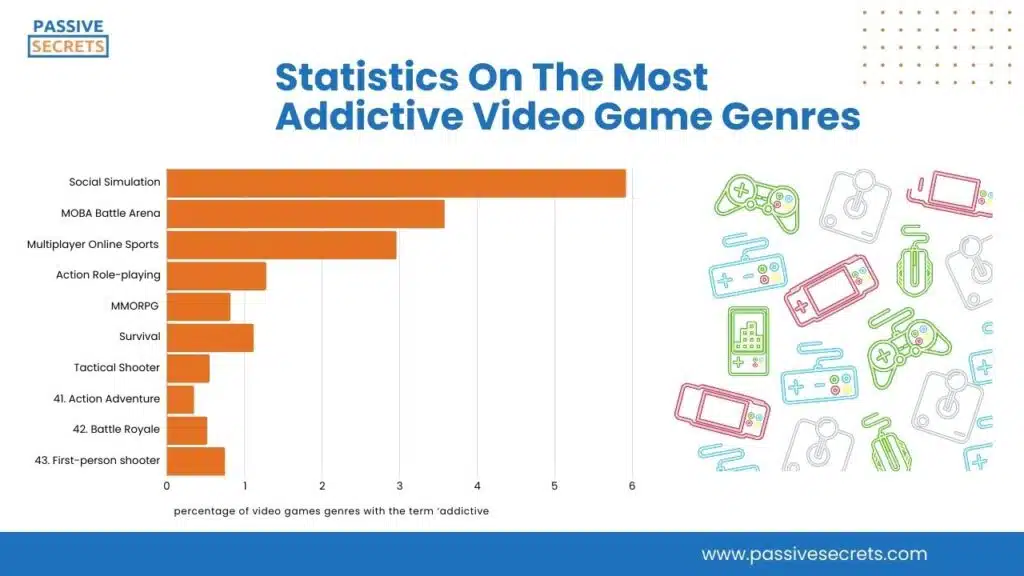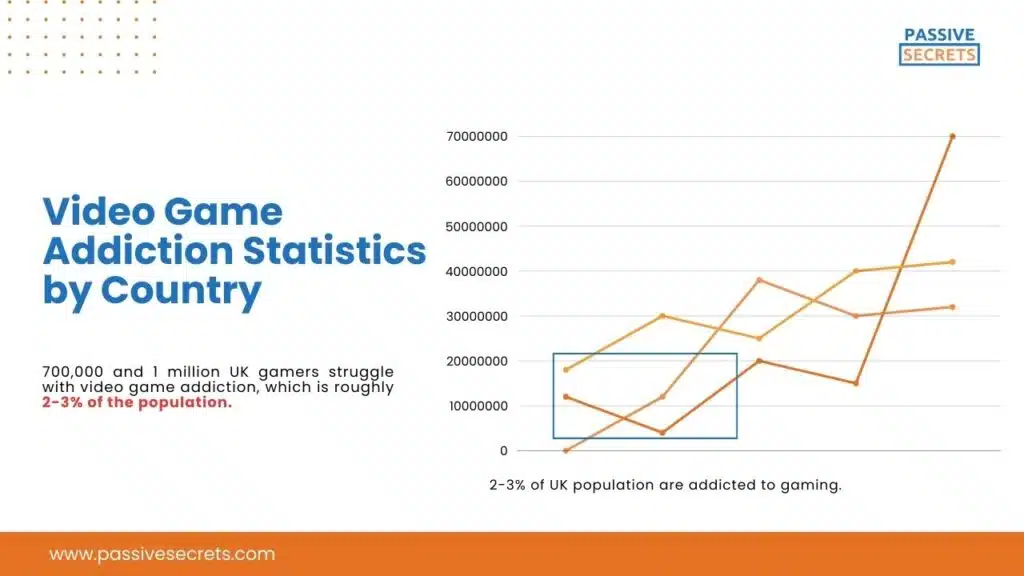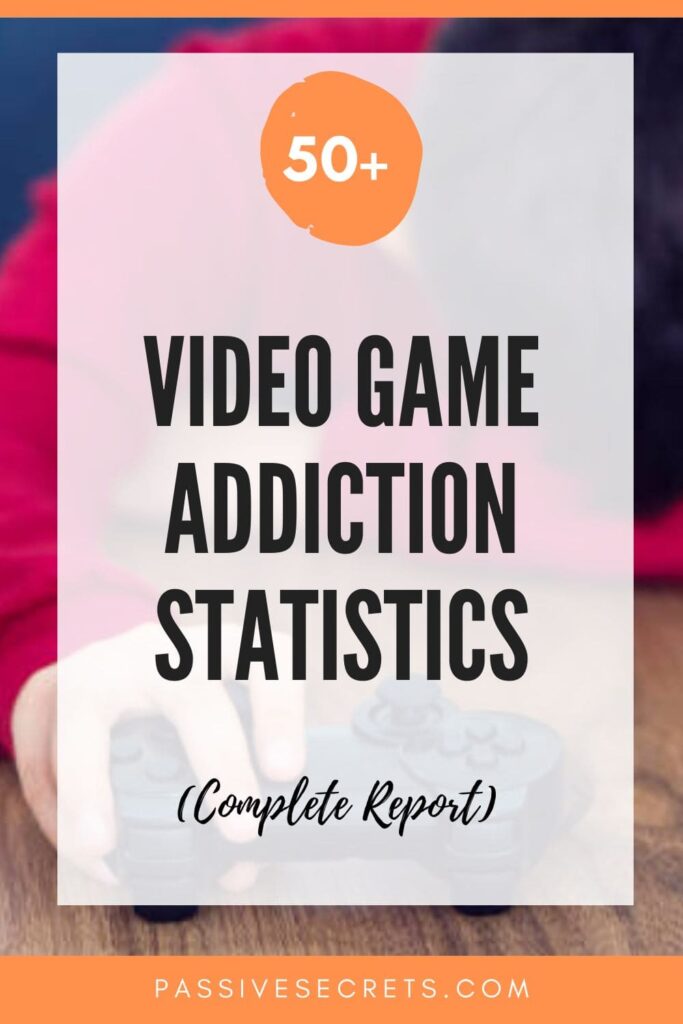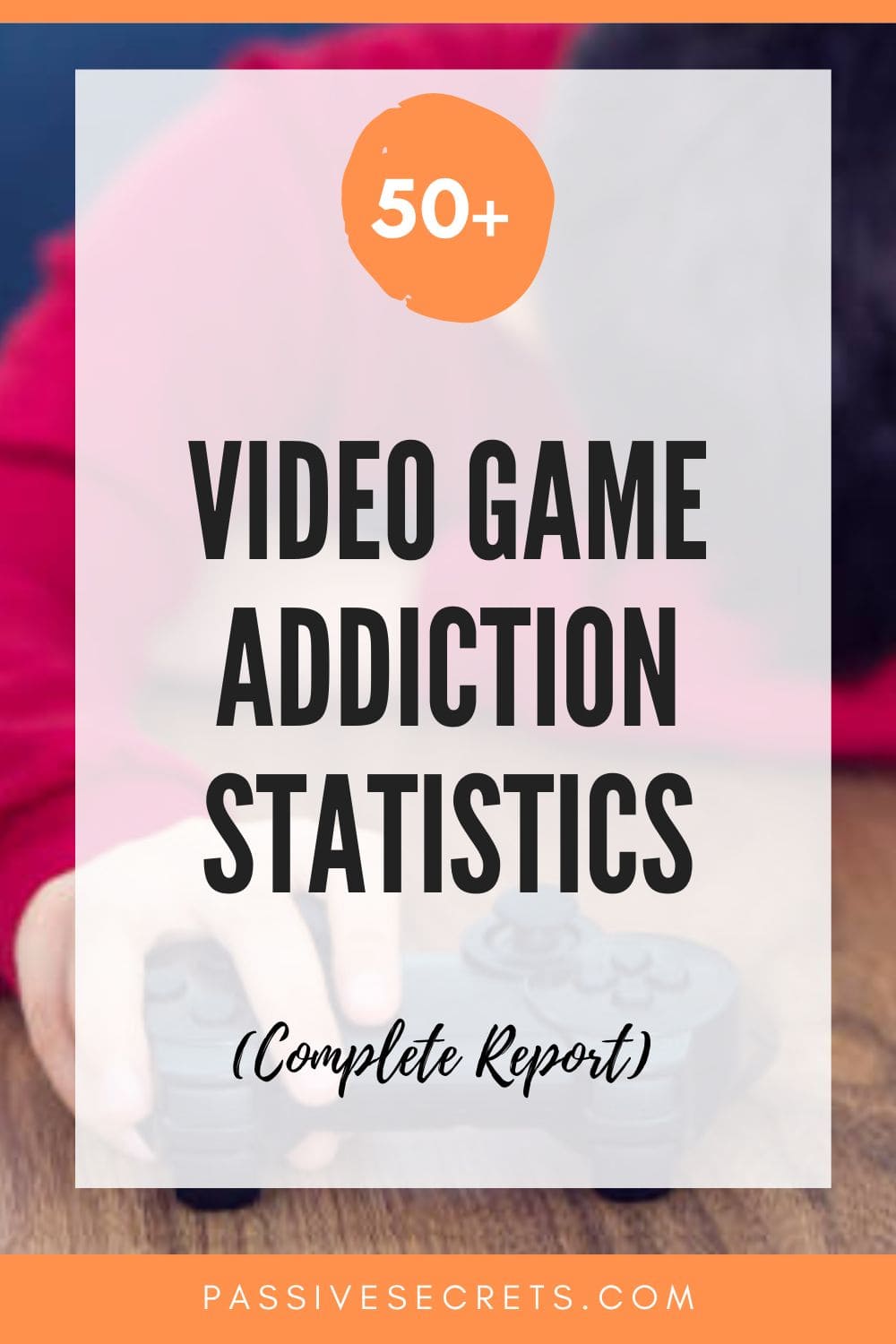
Ever wondered about the real deal with video games? Well, get ready for a ride into the world of video game addiction statistics.
We’re talking about those times when gaming goes from fun to a bit too much.
There’s a thin line between enjoying video gaming as a favorite hobby and being addicted to it. Video game addiction, also known as Internet Gaming Disorder (IDG), has become prevalent in society.
In 2022, WHO classified video game addiction as a mental health disorder.
So what does this mean?
I’ve got 52 video game addiction stats that reveal what’s really happening behind the screen. It’s not just numbers; it’s like peeking behind the curtain of our gaming habits.
So, join in – we’re about to keep it real with the highs and lows of video gaming.
Video Game Addiction Statistics (Key Data)
- 60 million people worldwide are estimated to be suffering from gaming disorders.
- The prevalence of video game addiction is higher among males, accounting for around 75-90% of cases.
- About 3-4% of video gamers worldwide have internet gaming disorders.
- Playing video games up to 10 hours a day or 30 hours a week is considered an addiction.
- 22% of American gamers spend between 61% and 80% of their time playing video multiplayer games.
- Rocket League is regarded as the most addictive video game right now, with 14.53% of reviewers deeming it addictive.
- Among adolescents, video game addiction rates range from 4% to 20%.
Global Video Game Addiction Statistics
1. Approximately 60 million people worldwide are estimated to be suffering from gaming disorders, according to various studies and statistics. (source)
2. About 3-4% of video gamers worldwide have internet gaming disorder. (source)
3. The video game market revenue is projected to reach $282.30 billion in 2024. Furthermore, the market is expected to grow at a CAGR of 8.76% between 2024 and 2027. Hence, it is expected to be worth $363.20 billion by 2027. (source)
4. The total number of video game users is expected to grow to 1.4 billion by 2027. (source)
5. In a 2021 systematic review and meta-analysis, the worldwide prevalence of gaming disorders was 3.05%. (source)
6. Approximately 160 million adults in the United States play online games. (source)
7. The total number of video gamers in the U.K. is expected to grow rapidly and reach 57.56 million users by 2027. (source)
8. Playing video games up to 10 hours a day or 30 hours a week is considered an addiction. (source)
9. The average video gamer plays for about 6 hours a week. (source)
10. Teens spend an average of almost 2 hours daily on video games. (source)
11. Between 0.3% and 1% of the general population have symptoms associated with gaming disorder. (source)
12. “Preoccupation with gaming” is one of the top symptoms of video game addiction. (source)
Other symptoms include:
- Withdrawal symptoms when not allowed to play games (sadness, anxiety, irritability)
- The need to spend more time gaming to satisfy the urge.
- Unsuccessful attempts to quit gaming
- Giving up or losing interest in other activities due to gaming
- Continuing to play despite problems.
- Lying to family members or others about the amount of time spent gaming.
- Using gaming to relieve negative emotions, such as guilt or hopelessness
- Risk, having jeopardized or lost a job or relationship because of gaming.
13. The COVID-19 pandemic caused a 39% increase in the worldwide average gaming time. (source)
14. The annual economic cost of video game addiction in South Korea is estimated to be $3.5 billion. However, the annual gain is $24.3 billion. (source)
15. In the United States, the average time that someone spends playing video games is 7.71 hours each week. However, the global average time is 8.45 hours. (source)
16. About 30% of Britons skipped meals and showers during the 2020 lockdowns to play video games. (source)
17. Men are more likely to develop a gaming disorder than women. (source)
18. The average age of a person who’s considered a gamer is 35 years old. The average age of someone with a gaming addiction is 24 years old. (source)
19. According to WHO, about 3% of the world’s population suffers from internet gaming disorder. (source)
20. The prevalence of video game addiction for teenagers has risen by 4% since the year 2007. (source)
21. The most vulnerable age group was 25-34 years old, with an estimated 147,577 people suffering from gaming addiction. Meanwhile, it is estimated that 129,980 people aged 16 to 24 suffer from video game addiction. The estimated number of addicted gamers aged 35-44 is 129,134, which is very similar to that of 16-24-year-olds. (source)
22. 22% of American gamers spend between 61% and 80% of their time playing video multiplayer games. (source)
23. In a survey, 67% of gamers say they have frequently missed sleep due to continuous gaming. (source)
24. Internet gaming disorder is closely linked to poor decision-making, impulse control, and emotion regulation. (source)
25. Video gaming addiction can lead to sleep disorders, depression, and anxiety. (source)
26. 90% of gamers do not engage in behaviour that is dangerous or has long-term consequences. (source)
Statistics On The Most Addictive Video Games

27. Rocket League is considered to be the most addictive video game currently, with 14.53% of reviewers deeming it addictive. (source)
28. ‘Animal Crossing: New Horizons’ was number 13 on the list, with 1.58% of ‘addictive’ reviews. (source)
29. Littlewood is second, with 12.50% of reviewers considering it addictive. (source)
30. ‘The Sims 4’, a strategic life simulation video game, had 0.97% reviews with the term ‘addictive.’ (source)
- Dota 2 – 1.68%.
- Tom Clancy’s RS: Siege – 2.02%.
- The Elder Scrolls V: Skyrim – 1.35%.
- Counter-Strike: Global Offensive – 1.27%.
- Fallout 3 – 1.28%.
- Call of Duty Black Ops III – 1.22%.
31. Demigod, claimed by 10.77% of reviewers as addictive, occupies the third rank. (source)
32. Stardew Valley, described as addictive by 6.67% of reviewers, holds the fourth spot. (source)
33. League of Legends, which 4.28% of reviewers find addictive. (source)
34. Path of Exile, another video game, has an addiction score of – 3.60%. (source)
Other addictive video games on the list include:
- My Time at Portia – 3.33%
- Fortnite – 2.59%
- Planetside 2 – 2.38%
- Frostpunk – 3.89%
Statistics On The Most Addictive Video Game Genres
35. According to Statista, the most addictive video game genre is the massive multiplayer online role-playing genre (MMORPG). (source)
Multiplayer Online Battle Arena (MOBA) is also one of the most addictive video game genres.
36. Other addictive video game genres include:
- Social Simulation – 5.92%.
- MOBA Battle Arena – 3.58%.
- Multiplayer Online Sports – 2.96%.
- Action Role-playing – 1.28%.
- MMORPG – 0.82%.
- Survival – 1.12%.
- Tactical Shooter – 0.55%.
- 41. Action Adventure – 0.35%
- 42. Battle Royale – 0.52%.
- 43. First-person shooter – 0.75%. (source)

Video Game Addiction Statistics By Gender
37. Males are more likely to develop video game addiction, accounting for approximately 75-90% of cases. (source)
38. Females are also susceptible to video game addiction, comprising around 10-25% of reported cases. (source)
Video Game Addiction Rates Statistics By Age
39. Among children aged 8-18 years, approximately 8.5% are estimated to be addicted to video games. (source)
40. Adolescents, particularly those in the age range of 13-18 years, are more susceptible to video game addiction, with prevalence rates ranging from 4% to 20%. (source)
41. Young adults (18-24 years) are another at-risk group, with studies reporting addiction rates ranging from 5% to 10%. (source)
42. Adults aged 25 years and above can experience video game addiction, with prevalence rates varying from 2% to 5%. (source)
Video Game Addiction Statistics by Country
43. 700,000 and 1 million UK gamers struggle with video game addiction, which is roughly 2-3% of the population. (source)

44. Over a quarter (26%) of UK adults played some form of online game in 2022, spending between one and five hours per week on video games. (source)
45. Before lockdown, the average UK gamer played video games 13 hours a week. (source)
46. According to a study by Macquarie University, 2.8% of Australian adolescents met the criteria for Internet Gaming Disorder. (source)
47. Males were more likely to be addicted than females, with rates of gaming addiction at 96% for boys and 6% for girls. (source)
48. 67% of Australians play video games regularly, with an average playing time of 89 minutes daily. (source)
49. In Japan, video game addiction has been recognized as a public health issue by the government. (source)
50. Studies show that Singaporean teens spend more time gaming than their American counterparts, 20 and 13 hours, respectively. (source)
51. In Taiwan, a 2018 survey found that approximately 6% of adolescents were severely addicted to online gaming. (source)
52. In Thailand, a survey found that children aged between 6 to 18 years old were addicted to video games. (source)
Trends in Video Games
The gaming industry is experiencing several trends expected to shape the landscape in the coming years. Some of the prominent trends include:
1. Retro-gaming
Retro gaming is when people play popular old video games. It has become more prevalent in recent years, and many companies are now remaking classic games for a new audience.
This shows that classic gameplay can be just as enduring as beloved music and movies from days gone by.
These remakes are not mere replications but a thoughtful fusion of nostalgia and modern gaming technology.
They blend familiar narratives with contemporary gameplay and graphics, allowing a new generation of gamers to experience a classic story in a new way.
2. Generative AI in Gaming
Generative AI, a form of artificial intelligence, is increasingly impacting the gaming industry.
It can accelerate game production by generating code, art, dialogue, and more, leading to richer and more immersive game worlds.
This technology will contribute to over half of the video game development in the next 5 to 10 years.
Generative AI can analyze player behaviour and in-game data to predict player actions and adjust the game’s elements, enhancing the gaming experience.
3. VR and AR Gaming
Augmented reality (AR) gaming integrates virtual elements with the real world.
In VR, users are visually cut off from the real world and require a dedicated headset and playing space.
On the other hand, AR games can be played from a smartphone, allowing users to see and navigate real-world locations while overlaying game visuals and audio.
These technologies offer immersive experiences, enhanced user engagement, and the potential for new and more powerful gaming applications.
4. Diversity in Games
Diversity in games is a trend that focuses on increasing representation in video games to better reflect our world.
This includes promoting gender, racial, and ethnic diversity in characters and storylines. The gaming industry has progressed in this area, but there is still a long way to go.
To address this issue, the industry needs to be more inclusive and diverse, both in terms of its workforce and the content it creates.
5. Subscription Gaming
Subscription gaming, a growing trend in the video game industry, offers access to various games for a recurring fee.
This model has grown, with the global subscription gaming market expected to reach $10.92 billion in 2024.
The subscription-based gaming model provides access to games on various devices, such as smartphones, PCs, tablets, consoles, etc., allowing users to stream or download games.
6. Mobile Gaming
Mobile gaming is a rapidly growing trend in the video game industry.
It has experienced significant growth, especially during the pandemic, as more people turned to games for entertainment at home.
The industry has seen an increase in players, although the number of paying players has reduced.
This trend has led to a greater focus on innovative monetization strategies and the need for game developers to adapt to market changes and push for innovations.
7. New Game Genres
New game genres are emerging yearly, and some dormant ones are returning.
Emerging game genres such as extraction games, realistic shooters, and arcade-style racing games are also gaining attention.
Some of the most prominent genres of 2024 will be extraction shooters, post-disco-era RPGs, and co-op horror games.
Game developers should consider genres such as roguelike deckbuilder, etc., which have audiences likely to try more than just one game.
FAQs On Video Game Addiction

Related Posts:
- Thought-Provoking Gender Inequality Statistics: 160+ Insights Across Regions
- 110+ Shocking Income Inequality Data You Need to Know
- 50 Interesting Sharing Economy Statistics You Need to Know
- 100+ Animation Statistics: The Ultimate Guide To The Industry’s Trends and Insights
- 80+ Franchise Statistics and Facts You Should Know In 2024
- The Future of Learning: 50+ Top EdTech Statistics For 2024
- The Web3 Statistics Report 2024: Trends, Insights, and Predictions
- Meme Statistics 2024: Facts, Trends, and Figures That Will Blow Your Mind
- 85+ MOST Interesting Anime Statistics and Facts (NEW Report)
- Board Game Statistics: Revenue, Market Size, Demographics & More
- 125+ Interesting Airbnb Statistics by Country (Deep Insights)
- 50+ Interesting Born Into Poverty Stay In Poverty Statistics
- 90+ Interesting Film Industry Statistics (NEW Report)
- 80+ Alarming Technology Addiction Statistics You Must Know
- 65+ Impressive Chess Statistics and Facts To Know in 2024
- Spotify Statistics: Latest Report on The Music Streaming Platform
- 50+ Vital Internet Safety Statistics & Facts You Must Know
- Internet Dangers Statistics: A Look At The Internet’s Dark Side
- 50 Interesting Bible Statistics and Facts You Didn’t Know
- 95+ Interesting Dream Statistics and Facts You Can’t Miss
- 75+ Interesting Relationship Statistics & Facts You Should Know
- Dance Statistics: A Deep Dive Into The Rhythm Of Movement
- 40+ Incredible Single Father Statistics You Have to Know
- The Battle of the Sexes: Male Vs. Female Spending Statistics
- 95+ Jaw-Dropping Period Poverty Statistics You Need To Know
- 70 Exciting Love Statistics And Facts (True Love, Intimacy, Marriage, Dating & Relationships)
- 30+ Gentle Parenting Statistics & Facts: Is This Parenting Style Worth It?
- 55+ Useful Black Consumer Spending Statistics (2024 Report)
- Holiday Spending Statistics: Valentine’s Day, Easter, Thanksgiving, & Christmas

